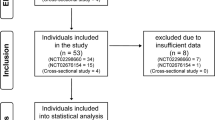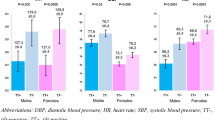Abstract
Study design:
An observational study.
Objectives:
To investigate the factors associated with silent autonomic dysreflexia (AD) during urodynamics (UD) in spinal cord injury (SCI) patients.
Setting:
Taichung city, Taiwan, ROC.
Methods:
Blood pressure (BP) and symptoms of AD were continuously monitored during UD, and systolic blood pressure (SBP) elevations >20 mmHg was considered an AD reaction. AD patients were divided into a symptomatic group and a silent group (without AD symptoms), and variables (basic demographic data, hemodynamic data and UD parameters) were compared.
Results:
A total of 42 patients, 21 in symptomatic and 21 in silent AD groups, were analyzed. Symptomatic group had significantly greater diastolic blood pressure (DBP) increment and rates of SBP/DBP changes (change of BP divided by duration) as compared to the silent group (29.5 vs 21.7 mmHg; 4.8 vs 2.3 mmHg min−1 and 2.8 vs 1.4 mmHg min−1) (P<0.05). The cutoff points of these three variables, determined by receiver operating characteristic analysis, are: DBP increment of 21 mmHg and rates of SBP/DBP change of 2.27 and 1.16 mmHg min−1. Age had a weak negative correlation with DBP change (Pearson’s r=−0.377, P=0.048) and the silent group was significantly older than the symptomatic group (49.4 vs 40.1 years, P<0.05).
Conclusion:
Patients with more symptomatic AD tended to have significant DBP elevation and more rapid SBP/DBP increments, and this was negatively correlated with age. Aging decreases AD symptoms and the magnitude of DBP elevation, possibly through the mechanism of decreased baroreceptor sensitivity. BP monitoring during UD and other invasive procedures is strongly recommended, especially for elderly SCI patients.
Similar content being viewed by others
Log in or create a free account to read this content
Gain free access to this article, as well as selected content from this journal and more on nature.com
or
References
Karlsson AK . Autonomic dysreflexia. Spinal Cord 1999; 37: 383–391.
Blackmer J . Rehabilitation medicine: 1. Autonomic dysreflexia. CMAJ 2003; 169: 931–935.
Lindan R, Joiner E, Freehafer AA, Hazel C . Incidence and clinical features of autonomic dysreflexia in patients with spinal cord injury. Paraplegia 1980; 18: 285–292.
Yarkony GM, Katz RT, Wu YC . Seizures secondary to autonomic dysreflexia. Arch Phys Med Rehabil 1986; 67: 834–835.
Eltorai I, Kim R, Vulpe M, Kasravi H, Ho W . Fatal cerebral hemorrhage due to autonomic dysreflexia in a tetraplegic patient: case report and review. Paraplegia 1992; 30: 355–360.
Linsenmeyer TA, Campagnolo DI, Chou IH . Silent autonomic dysreflexia during voiding in men with spinal cord injuries. J Urol 1996; 155: 519–522.
Perkash I . Pressor response during cystomanometry in spinal injury patients complicated with detrusor-sphincter dyssynergia. J Urol 1979; 121: 778–782.
Curt A, Nitsche B, Rodic B, Schurch B, Dietz V . Assessment of autonomic dysreflexia in patients with spinal cord injury. J Neurol Neurosurg Psychiatry 1997; 62: 473–477.
Giannantoni A, Di Stasi SM, Scivoletto G, Mollo A, Silecchia A, Fuoco U et al Autonomic dysreflexia during urodynamics. Spinal Cord 1998; 36: 756–760.
Consortium for Spinal Cord Medicine. Acute management of autonomic dysreflexia: individuals with spinal cord injury presenting to health-care facilities. J Spinal Cord Med 2002; 25 (Suppl 1): S67–S88.
Krassioukov A, Warburton DE, Teasell R, Eng JJ . A systematic review of the management of autonomic dysreflexia after spinal cord injury. Arch Phys Med Rehabil 2009; 90: 682–695.
Huang YH, Bih LI, Chen GD, Lin CC, Chen SL, Chen WW . Autonomic dysreflexia during urodynamic examinations in patients with suprasacral spinal cord injury. Arch Phys Med Rehabil 2011; 92: 1450–1454.
American Spinal Injury Association and International Medical Society of Paraplegia e. Reference Manual of the International Standards for Neurological Classification of Spinal Cord Injury. American Spinal Injury Association: Chicago, IL. 2003.
Haylen BT, de Ridder D, Freeman RM, Swift SE, Berghmans B, Lee J et al An International Urogynecological Association (IUGA)/International Continence Society (ICS) joint report on the terminology for female pelvic floor dysfunction. Neurourol Urodyn 2010; 29: 4–20.
Weld KJ, Graney MJ, Dmochowski RR . Clinical significance of detrusor sphincter dyssynergia type in patients with post-traumatic spinal cord injury. Urology 2000; 56: 565–568.
Barton CH, Khonsari F, Vaziri ND, Byrne C, Gordon S, Friis R . The effect of modified transurethral sphincterotomy on autonomic dysreflexia. J Urol 1986; 135: 83–85.
Dampney RAL . Cardiovascular and respiratory reflexes: physiology and pharmacology. In: Low PA, Benarroch EE, (eds).. Clinical Autonomic Disorder 3rd edn. Lippincott Williams & Wilkins: Philadelphia. 2008.
Franklin SS, Wt Gustin, Wong ND, Larson MG, Weber MA, Kannel WB et al Hemodynamic patterns of age-related changes in blood pressure. The Framingham Heart Study. Circulation 1997; 96: 308–315.
Folkow B . Structure and function of the arteries in hypertension. Am Heart J 1987; 114 (4 Pt 2): 938–948.
Lipsitz LA, Novak V . Aging and Autonomic Function. In: Low PA, Benarroch EE, (eds).. Clinical Autonomic Disorders 3rd edn. Lippincott Williams & Wilkins: Philadelphia. 2008.
Acknowledgements
This study is supported by a research grant from the Chung Shan Medical University Hospital (grant no. CSH 2009-B-005).
Author information
Authors and Affiliations
Corresponding author
Ethics declarations
Competing interests
The authors declare no conflict of interest.
Rights and permissions
About this article
Cite this article
Huang, YH., Bih, LI., Liao, JM. et al. Blood pressure and age associated with silent autonomic dysreflexia during urodynamic examinations in patients with spinal cord injury. Spinal Cord 51, 401–405 (2013). https://doi.org/10.1038/sc.2012.155
Received:
Revised:
Accepted:
Published:
Issue date:
DOI: https://doi.org/10.1038/sc.2012.155
Keywords
This article is cited by
-
Characterization of heart rate changes associated with autonomic dysreflexia during penile vibrostimulation and urodynamics
Spinal Cord (2023)
-
Recent updates in autonomic research: advances in the understanding of autonomic dysfunction after spinal cord injury
Clinical Autonomic Research (2023)
-
Heart rate changes associated with autonomic dysreflexia in daily life of individuals with chronic spinal cord injury
Spinal Cord (2022)
-
Quantitative analysis of dysautonomia in patients with autonomic dysreflexia
Journal of Neurology (2021)
-
Prediction of autonomic dysreflexia during urodynamics: a prospective cohort study
BMC Medicine (2018)



